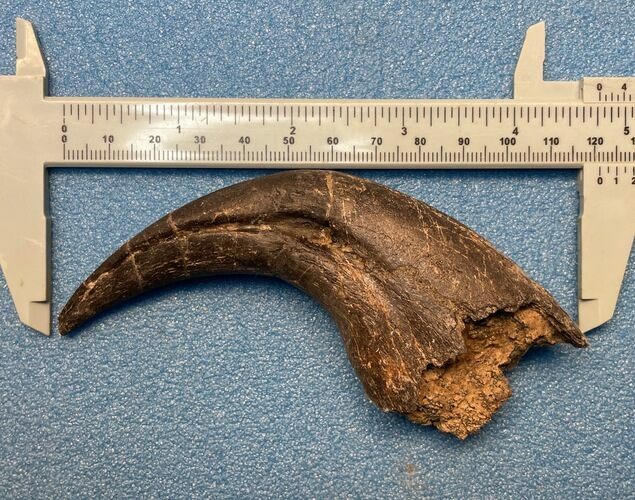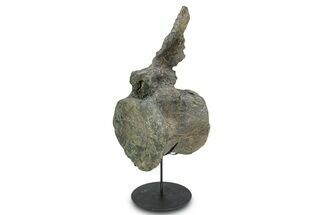This Specimen has been sold.
4.5" Spinosaurid Dinosaur (Suchomimus) Hand Claw - Niger
This is a beautiful, 4.5" long, fossil Spinosaur (Suchomimus tenerensis) hand claw from the Erlhaz Formation of Niger. It has dark black preservation and is complete all the way to the tip. The only restoration is a small wedge in the middle of the claw where a gap needed to be filled.
Suchomimus was a large predatory carnivorous dinosaur from the early Cretaceous period of Niger, 125-112 million years ago. As a theropod, Suchomimus's post-cranial skeleton was similar to many other theropods of the time, with two strong legs and comparatively smaller arms. However, being a spinosaurid, those arms were larger compared to other theropods, and their claws were especially massive and recurved. This, combined with their unique skull anatomy-- crocodilian in shape and function--would have made them excellent predators of all things piscine. Suchomimus was fairly robust and likely not any less dangerous on land as well. Suchomimus reached 30-36 feet long and weighed around 4 tons, which would have been fearsome to anything smaller than it.
The Elrhaz Formation is a geological formation in central Niger first deposited during the Early Cretaceous, about 125 to 110 million years ago. Though it currently sits in the arid Ténéré desert, it provides a snapshot of a once lush, marshy floodplain in the prehistoric world.
Elrhaz is best known for its fossil graveyards, carrying remains of ancient fish, crocodylians such as the famous SuperCroc (Sarchosuchus imperator), several species of ornithischian dinosaurs, the sauropod Nigersaurus taqueti, and several tetrapods including the fearsome Suchomimus tenerensis, a spinosaurid known from a partial skull and associated skeleton.
Elrhaz is best known for its fossil graveyards, carrying remains of ancient fish, crocodylians such as the famous SuperCroc (Sarchosuchus imperator), several species of ornithischian dinosaurs, the sauropod Nigersaurus taqueti, and several tetrapods including the fearsome Suchomimus tenerensis, a spinosaurid known from a partial skull and associated skeleton.
SPECIES
Suchomimus tenerensis (Sereno et al, 1998)
LOCATION
Gadoufaoua, Niger
FORMATION
Erlhaz Formation
SIZE
4.5" long (straightline)
CATEGORY
SUB CATEGORY
ITEM
#245482
We guarantee the authenticity of all of our specimens.
 Reviews
Reviews










